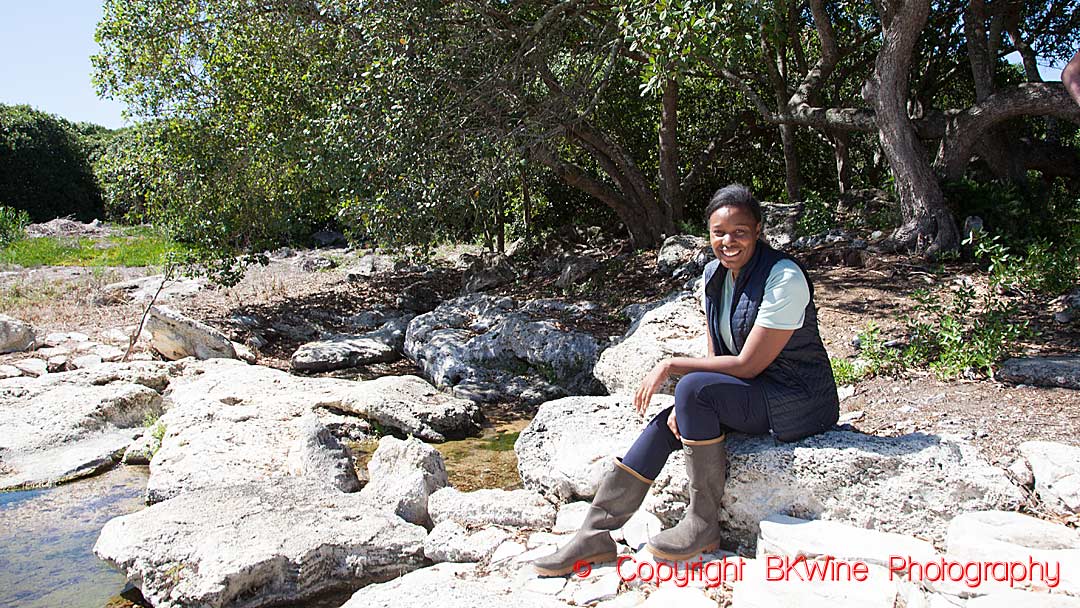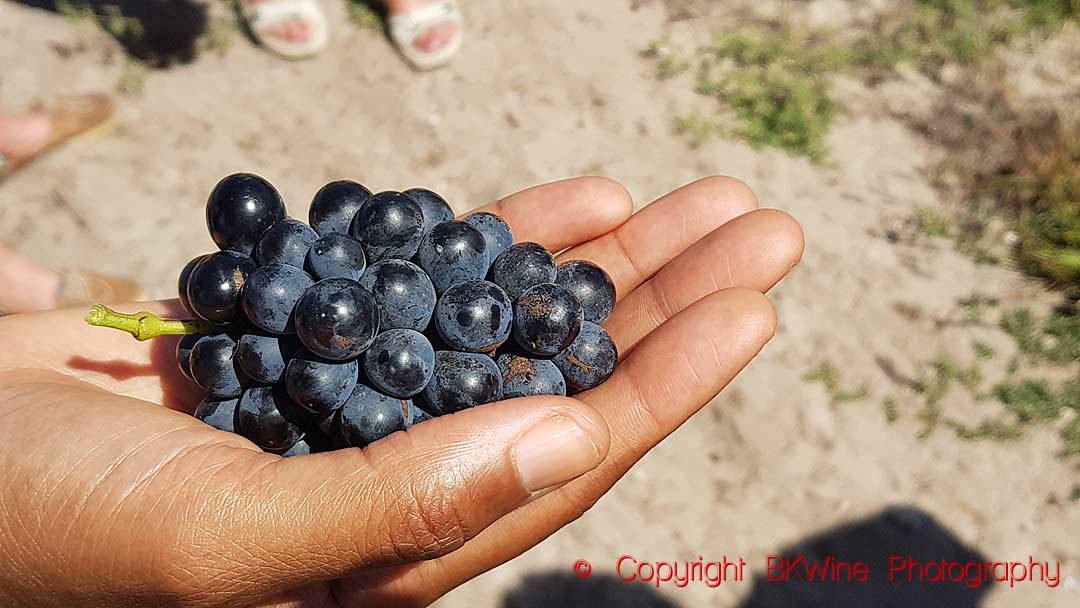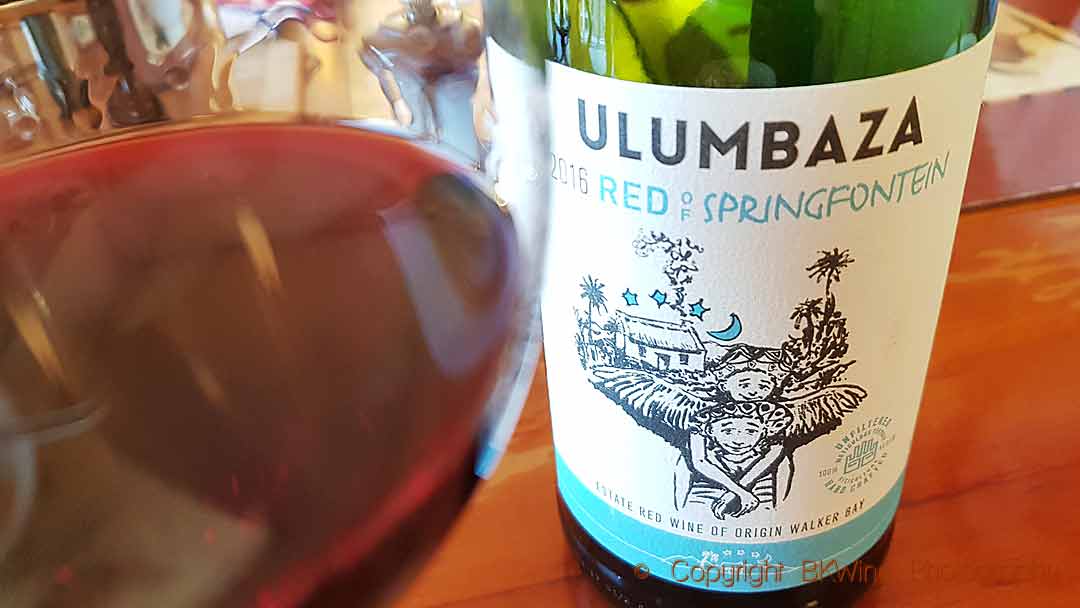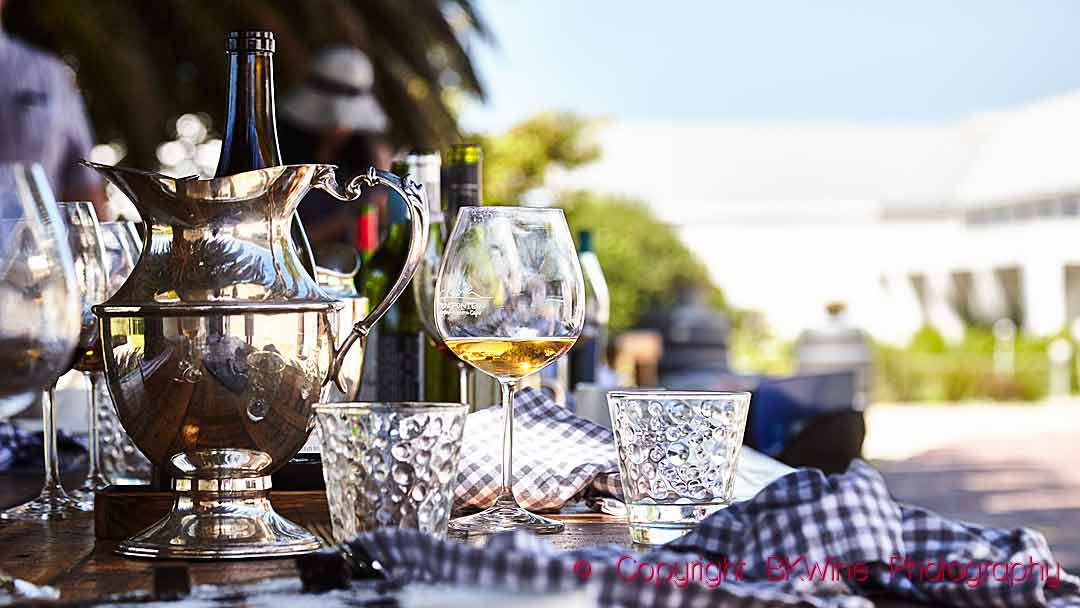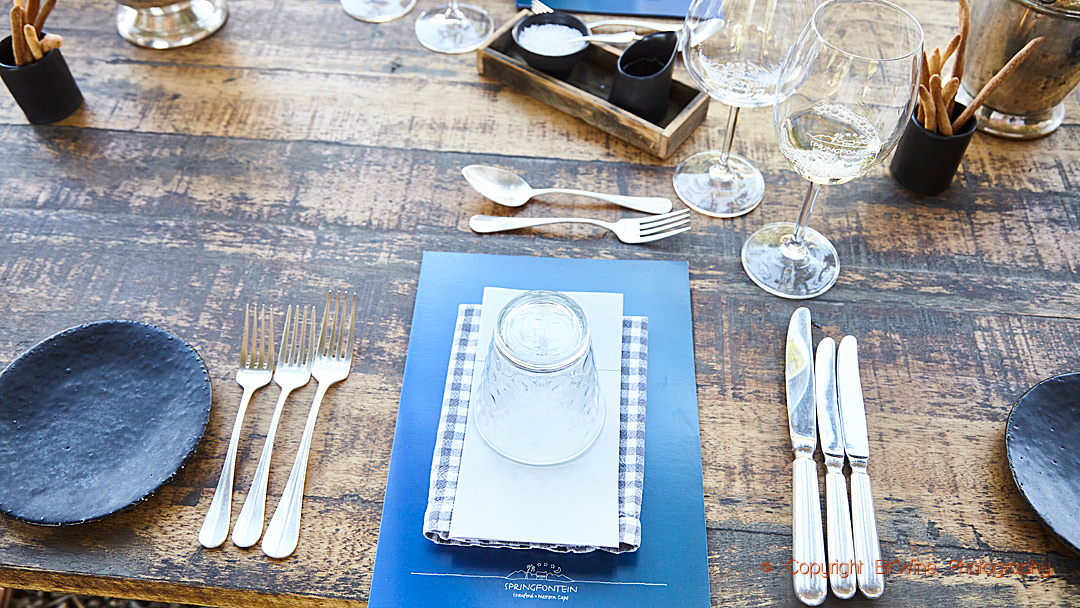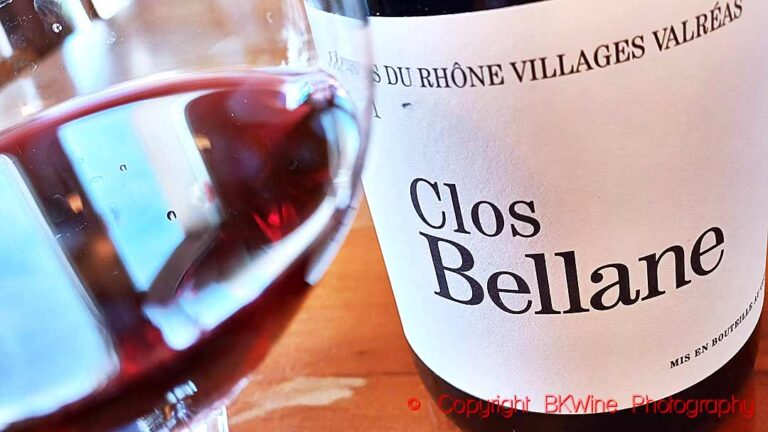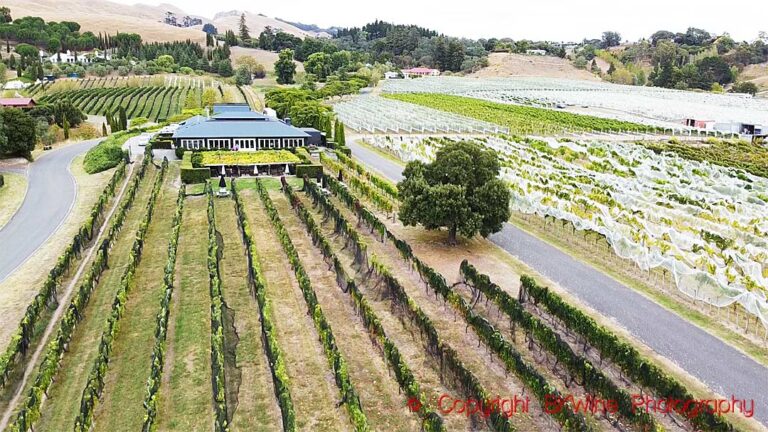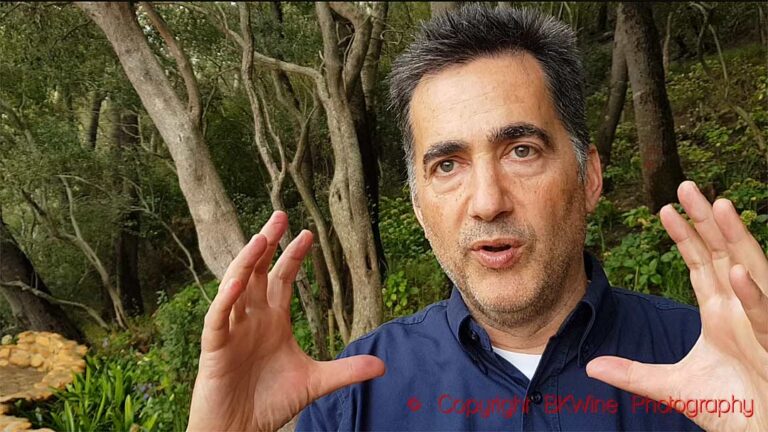Springfontein Wines is, in some ways, very similar to many other small wineries in South Africa, and in other ways, it is very different. What it shares with many other small entrepreneurial wineries in the country is that they make excellent wines that often are astounding value for money. What is different from others then? Well, it’s essentially all the rest of the story: the people, the wines, the place. If you want to go visit them, you really have to make an effort; they’re not in a famous region and at the end of a very bumpy road. But it is worth making the effort.
I remember the first time I came here to Springfontein. It must have been in 2017. Walker Bay had become famous with its Hemel en Aarde Valley, the new cool region. But don’t turn left into that valley; just continue straight until you come to the small town of Stanford. It’s a small town, quite charming, with 5000 inhabitants and famous for, well, nothing much. Wikipedia lists the town hotel and the local beer brewery as the main attractions. For a bird-lover, it is probably a great place. It is in an area famous for the many indigenous birds species. To be honest, Stanford does seem like a very lovely and peaceful town, although there’s a rather terrifying South African crime detective novel where it features (Sacrificed, by Chanette Paul, our review here).
An article in our series of talks with South African winemakers. Read all here:
- Springfontein Wines, surprising and extraordinary South African
- Hidden high up in the Stellenbosch mountains is a gem, Oldenburg Vineyards
- Kaapzicht, a pinotage pioneer and cabernet champion in Stellenbosch
- Both classic and unusual, Stark-Condé Wines in Stellenbosch, South Africa
- Aslina Wines, Ntsiki Biyela’s new venture, and the future of South African wine
- DP Burger at Glenwood Vineyards in Franschhoek, South Africa
And also:
This is a longer version of an article published on Forbes.com.
Then you go straight through Stanford and out on the other side. This is where the washing-board dirt road takes over. Driving on it gives you a free African massage, as our guide at the time pointed out. Eventually, you arrive at the winery and the well-tended whitewashed buildings, for instance, the old barn, now re-born as The Wine Bar(n), where they used to keep hay and now serve wine…
The crazy German comes to South Africa
But back to the wines and the winery. It started as a crazy idea and a whim. Johst Weber, a German natural resource specialist, had for some time been toying with the idea of buying a property where he could plant wines and have as a retreat to meet family and friends. In 1996, he came to South Africa for the first time, partly lured to come here by an article on South African wine in Decanter Magazine.
It took him all of two days to find and decide to buy Springfontein. It is a bit hard to understand. It was, at the time, probably a three-hour drive along the coast through land that was mainly used for apple and fruit farming. The Springfontein farm had been more or less abandoned for a decade and certainly did not produce any wine. And yet, this was what Johst fell for. Abandoned land, farmhouses in ruins. You wouldn’t recognise it today.
The story of how we found Springfontein is a bit similar (perhaps less crazy). Around 2016, we (BKWine) had decided to extend our South Africa wine tour with some days in Walker Bay, which had then become famous for Hemel en Aarde, the “hot” (as in hip) cool-climate region. But we also wanted to do something beyond the valley, so we found Springfontein, which seemed a nice enough place close to Stanford.
When we arrived, we were greeted by the then-winemaker, Tariro Masayiti. Tariro was from Zimbabwe and was also one of the few black winemakers in South Africa. Tariro had lots of unusual ideas. A skin-macerated sauvignon blanc. A white (!) pinotage. A series of wines called “Limestone Rocks” called things like “Dark Side of the Moon” and “Whole Lotta Love” (Tariro is a rock music fan). And several other (excellent) oddities too. Strangest of all is perhaps Springfontein’s new “chenel”, made from a grape variety called chenel, a unique South African grape from which, as far as I know, no one else makes wine.
All change, all stay the same
And then the story gets even more extraordinary. In 2022 Tariro left Springfontein. I was a bit worried. What would now happen? I should not have worried. The “new” winemaker had been at Springfontein for some time. Oh, sorry, I shouldn’t say winemaker; Jeanne Vito doesn’t like being called winemaker. She doesn’t “make” wine. Instead, she is head vigneronne, tending the vines and coaxing the grapes into wine. If Tariro’s history was unusual, Jeanne’s is even more so.
She was born and grew up in Chablis. Yes, Chablis, in France. Her father is from Benin, and her mother is from Togo (just west of Nigeria in West Africa). They had moved to France to work in the Burgundian vineyards, and this is where Jeanne was born. I wouldn’t be surprised if Jeanne were the only coloured child growing up in Chablis at that time, a tiny French countryside town. She studied wine sciences and commerce in Burgundy and worked as an international wine consultant based out of France.
One day, Jeanne was at a dinner in Germany and happened to be seated next to this guy who owned a winery in South Africa. Johst. Apparently, the discussion was fruitful, and it led to Jeanne joining the Springfontein team in 2018 and then taking over from Tariro in 2022. In the meanwhile, she also married Johst, so together, they now manage Springfontein.
Wine from Togo
But that is not the end of Jeanne’s story. She has also planted a vineyard in Togo, her mother’s native country. This is a project in honour of her father to realise his dream of creating a vineyard in Togo. The first Togo wine is to be released in a few years’ time.
Why “Springfontein”?
There’s a very good reason why the winery is called Springfontein. It’s a curious name since fontein is Afrikaans for fountain or well (or spring), so it is, if you want, “Spring-Spring”. There is a spring on the property, which is the one that has given the name to the estate. The spring gave sufficient water to make the land arable. It is still there, in a beautiful spot, almost like an oasis, surrounded by green trees.
A conversation with Jeanne Vito, vigneronne, and 364 years of South African wine
When I last was at Springfontein, I sat down and talked with Jeanne.
First, I wanted to understand why being a vigneronne and not a winemaker is important. “Vigneronne” (or vigneron, as masculine) is a French word that would usually be translated to “winemaker”, but the emphasis is different. “Vigne” means “vine”, so the focus is on the vineyard, not on the “making”.
Jeanne explains, “I like to extend this word (winemaker) to ‘vigneronne’ simply because I’m French first of all. Being born and raised in Burgundy, Chablis. We have a whole connection with nature where, in fact, the wines start in the vineyard. To make a great wine, you will obviously need to have great grapes. To make great grapes, you obviously need to have a great vine. Now, to make a great wine you need to have a generous nature giving you the great terroir. So was it the soil, whether it’s the wind, whether it’s also the beautiful sun that we can have here, the exposures.”
But it is not only nature, it is also people, “It’s also the people working with that terroir and for that terroir. So, for me, it’s more than the word vigneron or the word winemaker; call it how you want to say. For me, it’s above all, a philosophy, a philosophy that is striving you to connect with the nature to better understand the nature in order to bring out the best out of what the nature is giving you. So, in the end, for me, it’s a whole philosophy where you are not really the one controlling what’s happening, because it’s the nature but you’re more rather here as a midwife, trying to just give birth to what the nature is giving you. That’s what I would call my vigneronne philosophy.”
I should perhaps not have played down Stanford as much as I did initially. Jeanne says about it, “It is a beautiful village,” just a short drive from Hermanus, which is the capital of whale watching and a charming fishing harbour town. “Stanford is, for me, the destination to go if you want to escape the city life, if you want to have the countryside experience, with obviously not just wine, but also food. We are so privileged here to have, I would say a whole community, dedicating to making the whole of Stanford alive.”
This location also gives Springfontein a special and very favourable micro-climate. On one side is the Kleinrivier Mountains, and on the other is the ocean. The ocean is always important for South African wine producers; they often call it the Cape Doctor. It comes with strong and cool winds that help keep the vineyards healthy.
On to the wines. Springfontein makes an eclectic range of wines. What are the ideas behind all these different wines? “The idea is simply to show to the world how different we are, and how the difference can be your strengths, in fact. We are not mainstream, we are doing things differently. But sometimes, we love to go beyond the extra mile, to be able to show what the nature combined to human sense can do. We consider ourselves as pirates.” Pirates, indeed. It is a theme that is evident on some of their labels.
Diversity
Clearly, a lot of philosophy goes into their wines, not just “winemaking” (oops!). Jeanne continues, “Springfontein is a land of opportunity where whoever wants to come and wants to connect with nature and wants to craft the wine together with us and to be able to pair it with great food. Everyone is welcome here regardless of your skin colour, regardless of your gender. Everything is permitted. I think that’s what we present Springfontein.”
“And obviously, it’s true that we have a wide range of wines, but it’s also represented diversity that we are here to bring full-time diversity, again, in terms of colours, but also in terms of origin. In terms of ethnicity, to some extent, that makes us who we are.” So, wine here is not just about making a drink; it’s also a statement about life and about people. This is, in fact, something that you encounter in many South African vineyards. Producing wine is , of course, the main objective, but it is often also about supporting the community and making sure the people can make a living.
Maybe that’s why many South African wineries talk about the staff on their websites, more than in other countries. Perhaps that’s why not only Johst Weber and Jeanne Vito are on Springfontein’s website but also Emil Jonathan Weber, Janine van des Nest, Elaine du Preez, Mariska Banton, Ashlin Bantom, Reneisha Diedericks, Zinhle Makhetha, Brian Ntonya, John Maklein, Simon Komsana, Ashmique Arendse, Martin Jantijes, Tafadzwa Chasara, and Xolile Mcotheli are there, all with name and photo.
This blend of culture and people could not be better illustrated than by Jeanne herself, a French national, married to a German, living and working in South Africa, with a father from Benin and a mother from Togo. “I consider myself an ‘Afro-pean’ (*). It’s a whole mix of who you are.” ((*) African-European)
With this varied background, where do you feel at home? I asked. “Where do I feel at home? In my head. For me, in my head. I am officially a nomad. A wine nomad. I had the privilege to travel the world, to live in different places. But all brought me to wine, as funny as it is. I left Burgundy, Chablis, a limestone region, to reach here, Springfontein, South Africa. That tiny little wine of origin Springfontein, with our limestone vineyard and that for me is it’s just a blessing and it’s more journey going on.”
Chenel, better than Chanel
So what about this wine that no one has ever heard about? Chenel.
Jeanne explains, “Chenel, not Chanel, c-h-e-n-e-l, in fact, a true South African white varietal. So this is a cultivar that has been existing since the 70s, which is a crossing of chenin blanc and trebbiano, which somehow has been forgotten here in South Africa, certainly because that cultivar has a thick skin like the pinotage. And people were also doubting about how they can use it effectively when producing wine. So, at Springfontein, we had plantings of the king of South Africa, pinotage, which we are specialising into, we decided on our limestone terroir to be able to find the queen of South Africa, the white variety, because in South Africa, the most planted cultivar is chenin blanc. So, it was important for us to give birth to that cultivar, which is chenel.”
“So we planted chenel, in fact, we have done our first harvest in 2020. And I just want also to give a big shout out to everyone who was able to contribute in not only planting this magnificent cultivar, but also to being able to bring that one alive. Whether is the past team, what is the current team, whether it’s going to be the future team, but the whole idea behind is to be able to truly demonstrate that in South Africa, you can make also not only South African wine coming from South African cultivar. So I hope maybe in 30-50 years people will give as much recognition for chenel that there is for pinotage. It’s actually, in fact, here our mission at Springfontein.”
Some tasting notes on the Springfontein wines
Springfontein makes a wide range of wines, not only oddities like chenel or white pinotage. They have a “Terroir” range with three single variety wines, the unique chenel, a red pinotage, and a chenin blanc. The Ulumbaza range is similar but made with blends, a red, a white and a rosé.
Pinotage is a grape that Springfontein is very fond of. They have a series of wines focussed on this grape, called Limestone Rocks: Whole Lotta Love, Gadda da Vida, Child in Time, Dark Side of the Moon. The last one is a white wine but with around a third of the grapes being pinotage, a red variety, giving it more body and a particular character. The names, as you can perhaps tell, are inspired by rock-and-roll music.
They make two single vineyard wines: Jill’s Dune and Jonathan’s Ridge, pure chenin blanc and pinotage respectively.
Finally, they have the series of “Daredevils’ Drums” wines, small batches of “oddities”, like the white Blushes Inverse Pinotage, a white pinotage.
A few short tasting notes on some of their wines:
2020 Terroir Selection Chenin Blanc, Springfontein
Typical of the grape, quite light in style, fresh and energetic.
2018 Single Vineyard Jil’s Dune Chenin Blanc, Springfontein
More sophisticated than the chenin wine; full-bodied but still fresh, a little floral.
2019 Terroir Selection Pinotage, Springfontein
A little maceration carbonique during the vinification, which gives juiciness, full of character, very good.
2020 Daredevils’ Drums Blanc de Pinotage ”Blushes Inverse”, Springfontein
Deep, dense mouthfeel, concentrated aromas, lots of berries.
2020 Terroir Selection Chenel, Springfontein
Quite discreet on the nose but expressive on the palate, a little floral, peach, a delicious wine.
2017 Limestone Rocks Whole Lotta Love, Springfontein
A “pinotage blend”, big structure, dense but with good freshness, aromatic.
2018 Jonathan’s Ridge Pinotage, Springfontein
Single vineyard estate wine. Quite big body, lots (!) of fruit, dark berries, dense structure. Possibly a touch too much oak. But simply as a whole very good.
2015Dark Side of the Moon, Limestone Rocks, Springfontein Wine Estate
A delicious blend of chenin blanc (43%), pinotage (38%) and chardonnay (19%). Former winemaker Tariro Masayiti called it a Cape White Blend. The wine is wild-fermented in open small oak barrels and then aged in French and Hungarian barrels. Full-bodied with structure, honey, stone fruit, apricot. A good length, great complexity, very good.
The magnificent food
It would be a great mistake not to mention the food. I have dined (lunched) at Springfontein a few times. It is always been exceptional, probably the best food I have had anywhere in South Africa, combined with its excellent range of wines. They have a fine-dining (gastronomic) restaurant called Wortelgat and a bistro, the Wine Bar(n). They also have some rooms if you want to stay overnight.
Over the years we’ve been coming to Springfontein, there have been different chefs. Last time, in 2023, they had a Dutch chef who, at home in the Netherlands, run a Michelin two-star restaurant. That tells you the level of ambition. Now, they have a new chef, Janine van der Nest, who is South African. Perhaps more in line with their philosophy. So, I imagine there will be more focus on South African food traditions, but no less delicious. Exciting.
I am looking forward to coming back!
Travel
You can discover many of the fabulous South African wines on a wine tour to South Africa with BKWine Tours, also including Franschhoek, Walker Bay, Elgin, Stellenbosch and much else.
Travel to the world’s wine regions with the wine experts and the wine travel specialist.
The most insightful wine tours. BKWine wine tours.






